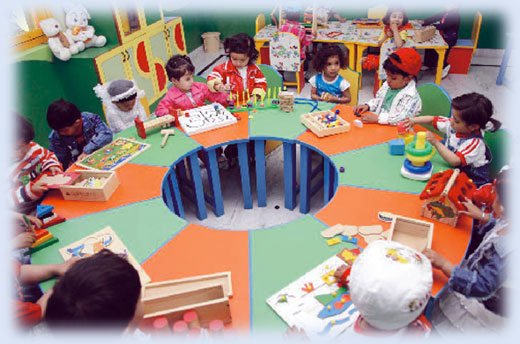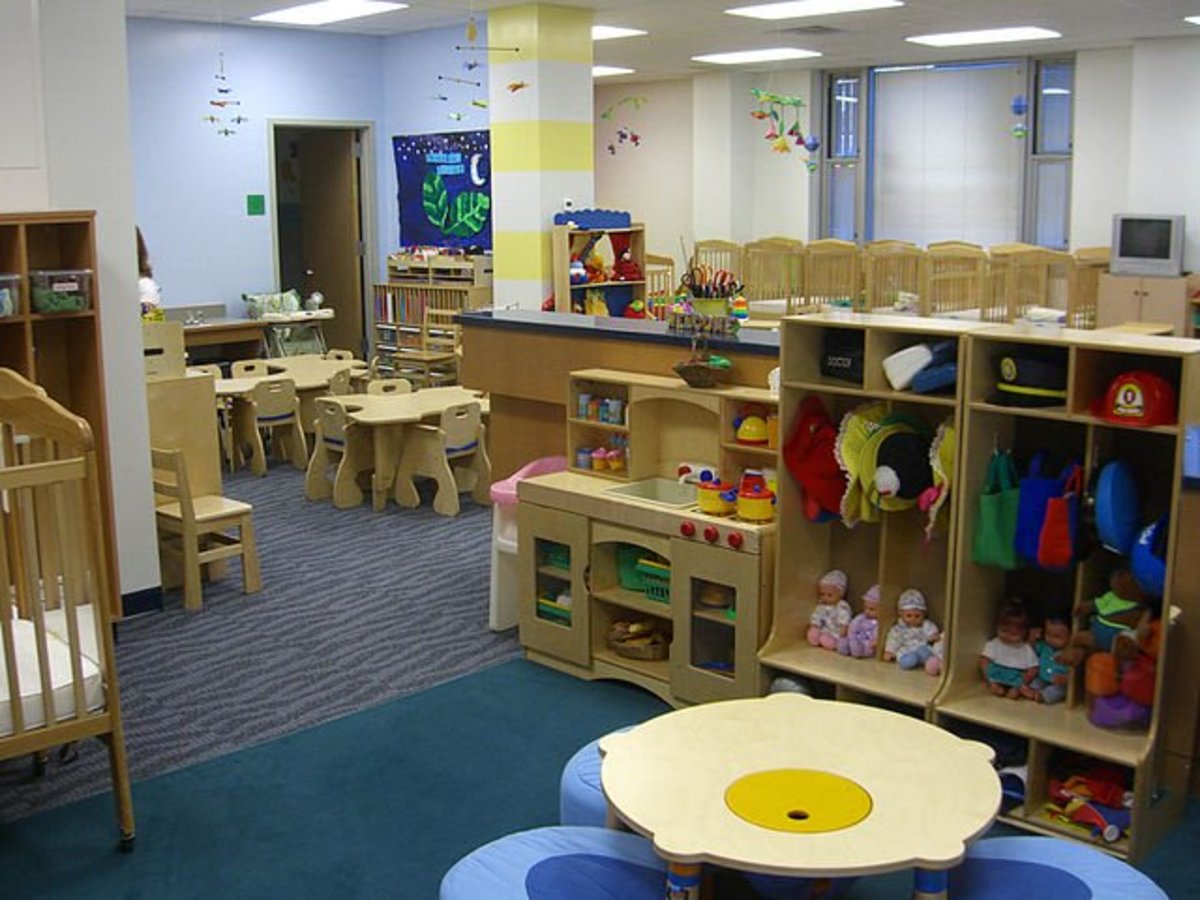Choosing a Daycare Center for Your Child

How do you choose a day care center for your child?
Choosing the right day care center for your child can be tricky. There have been so many stories on the news about abuse in child care settings. The idea of putting the health and safety of your child in the hands of someone else, someone that you don't know, can be scary.
There are a few things to look for, and a few things to avoid when looking for a child care center for you child. First to consider is what type of environment do you want for your child?
There are family-style child care settings, which are most often run out of someone's home. There are also different types of centers available as well. Some are straight day care centers, offering basic services. They are basically babysitters for you child. There are also more educationally based centers available. They offer a full curriculum, with educational activities throughout the day. Whatever suits your needs, there are things you need to look for, and thing you want to avoid.
Home-based Day Care
Some people are more inclined to chose a home-based day care provider over a day care center. They are a great choice, because they provide a home-like environment. They usually have an age range of children, and have a smaller number of children. They tend to have somewhat flexible hours. Though, it can be tricky to find alternate child care, should the home based provider decide to take vacation, or become ill.
If you decide to go with a home-based provider, make sure they have all the proper licenses for running a home day care business. Information on what licenses are required can be easily found on the internet, or through your local Health Department. Many people offer child care out of their homes without ever receiving the proper licenses. They should be able to provide proof of licenses on demand, including current First-Aid and CPR certification cards. In the United States, First-Aid certification is valid for 3 years and CPR needs to be renewed annually.
Make sure you have a legal contract signed by both you, and your home-based child care provider. That way, both you and the child care provider are protected should any issues arise. Usually, a licensed home care provider will have a standard contract for you to look over and sign, on hand. They are also required to file taxes, so you are still eligible for any tax credits available for child care. They should be able to provide you with a receipt of child care costs paid for the year.
There are some issues to remember about home-based child care. There are rarely security cameras in someone's home, so should any questions arise, it is hard to verify the statements made by your child or the child care provider. Be sure to choose a provider that will let you drop by anytime, unannounced, to visit your child. If they don't allow you to stop by whenever you want, that should be a warning to you. You should be allowed to stop by and visit whenever you want.
Make sure to inspect the areas that the children will be in. A quality home day care provider should be perfectly willing to give you a thorough tour of the areas that the children will be in. Are all the proper safety measures taken? Do they have outlet covers and cabinet locks? Do they have safety gates installed on stairways? Are there dangerous or fragile materials within the reach of the children? Are the play structures and equipment in good shape? Are the toys in good repair? Is the food prep area clean? Is the bathroom clean? These are all things you need to look at and take into account when choosing a home-based child care provider. Just remember, clutter does not mean it's not clean. Children play in these areas, and often are not the best at putting toys away when they are done.
Home-based child care can be the best thing if you have a child that tends to rely on an older sibling. There is usually no separation based on age. All the children play together, much like in a family environment. However, there is often little educational stimulation for the children in a home day care. This is by no means the rule, as I do know home care providers who do provide educational opportunities. Home-based care is often a great fit for many families, as it offers a closeness with the child care provider. They become a friend to the child, especially if the child remains in the care of that one child care provider for several years. It avoids the issues of a new teacher every year.

Daddy Day Care
Child Care Centers
Child care centers are another option out there. They usually have set hours, discounts for multiple children, and provide a greater sense of security for a lot of parents. Choosing a center can be difficult. There are a lot of things to think about when choosing a day care center.
Do your research. Look online for information on the centers in your area. Visit each center before deciding on one. Talk to friends in the area, and get recommendations from them on what centers they like and don't like. You can usually get a great deal of information from your friends that you might not be able to find online. Take your time; don't just pick the first name out of the phone book. It is a very important decision. The well-being of your child is worth the effort.
Like I said, visit each center. They should be willing to take you on a guided tour of the center. Ask questions. What are the age ranges? How are they divided up? What are the teacher-to-child ration in each age group? The center I worked at provided care for children from six weeks all the way to age 5. The classrooms were divided up as such:
Infants- six weeks to one year(or until child is walking). Ratio 1 to 4 meaning one caregiver for every four infants. Maximum of eight infants and two caregivers per room.
Pre-toddler-one year to two years old. Ratio 1 to 5, meaning one caregiver for every five children. Maximum of ten children and two caregivers per room.
Toddler- two years to three years old(or until child is potty trained). Ratio of 1 to 7, meaning one caregiver for every seven children. Maximum of 14 children and two caregivers.
Pre-school- three years old to five years old. Ratio of 1 to 12, meaning one caregiver for every 12 children. Maximum of 24 children and two caregivers.
In the pre-school age group, the children were divided up further. There were separate rooms for three-year olds, and four and five-year olds.
There was also a part-day classroom. This was for children who attended kindergarten, or for those parents that only wanted a part-day pre-school program for their children.
Some centers run full day, some only part day, and some only a couple days a week. Most pre-schools run part day, a few days a week, and are there more for preparing a child for school than for providing day to day child care for your child.
In your tour through the center, look around, and pay attention. Look for safety concerns. Basics like outlet covers, fire alarms, carbon monoxide detectors, and fire extinguishers need to be in place. Check for emergency evacuation procedures. They should be posted in every room, usually on the doors. Check out the playground equipment. Check out the rooms. Are they clean? Are the toys organized and in good shape? Are there security cameras in all the rooms? Is the center fenced in?
Ask questions about procedures. Do they require identification when you pick up your child? What sort of process do they use to sign a child in and out? Some centers have cards that you have to swipe upon entering the center. Some require you to sign a child out at the front desk and again in the child's room. Make sure they have a safe system for verifying who is picking the child up from the center. Again, be sure that you are allowed to visit your child any time that you want. Be wary of any center that does not allow unannounced visits to your child.
When you look at the room your child will be in, look around. Is it inviting? Does it look like a place your child will enjoy? Are there a wide variety of toys and play areas for your child, and the number of children that will be in that room? Does each child have a place to store his or her personal belongings? Is there artwork done by the children displayed about the room? Are the tables and chairs sized appropriately for the age group?
Some child care centers, and all pre-schools, provide an educational curriculum. Ask what sort of curriculum the center provides. They should be able to provide you with some schedule of day to day activities, or even a lesson plan for the entire week. Sometimes these are on display in the classroom. What sort of topics do they cover? Do they include science and cooking activities? Children learn through play, so these activities should be based around that basic concept. Something as simple as making play-dough can be a science activity. Leaf rubbings are not only art, but also science.
Avoid centers that don't allow you to visit, and that don't have security cameras. Make sure the bathroom area is somewhat open, yet allows for privacy. The outdoor areas should be fenced in and have safe, maintained equipment. The center should have current accreditation and licenses. All staff, including cooking and maintenance staff, should have proper First-Aid and CPR training. The center should be clean and well maintained.

© 2008 Anna Marie Bowman







